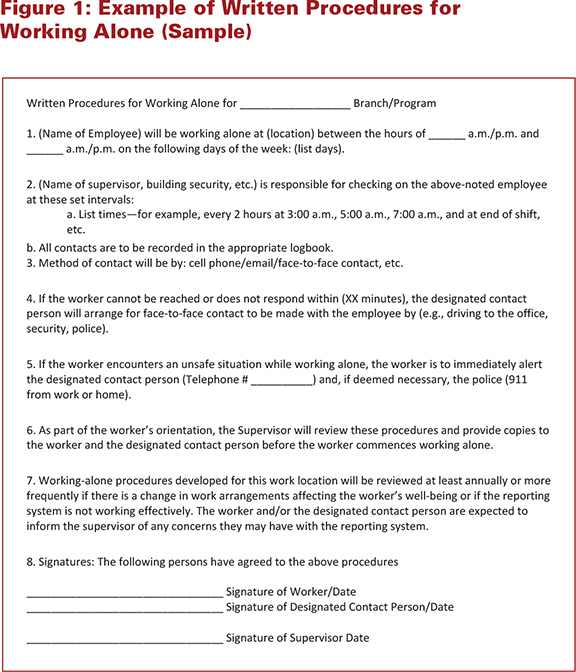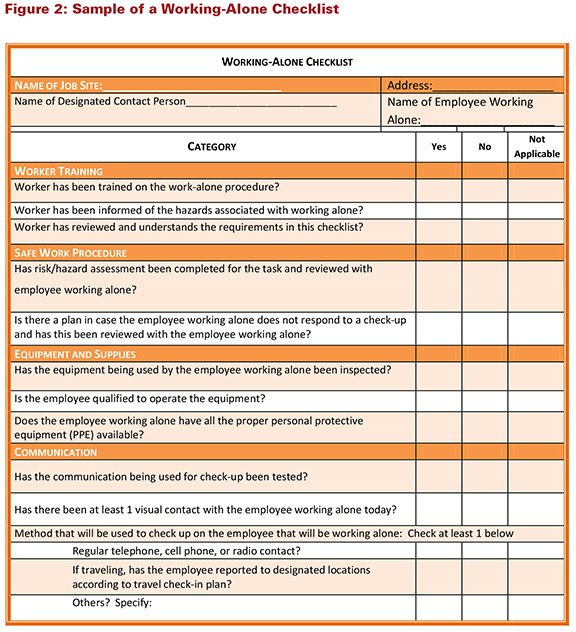Safety Procedures for Employees Working Alone
While
it is acceptable for employees to work alone (unless a federal, state, or local
agency prohibits it), proper steps must be taken up front to provide them and
others with procedures to follow to ensure their health and safety. Businesses
should check the guidelines from the Occupational Safety and Health
Administration (OSHA) to ensure that their working-alone procedures follow all
federal rules
and regulations.
The
first step in developing a working-alone procedure is defining what the term
means. Different companies may refer to a single-worker situation as an
employee working alone, a lone worker, or a single-worker job. Regardless of
the terminology, the concept generally refers to a situation where 1 person is
performing a task by himself, he cannot be seen or heard by other workers, and
assistance is not readily available. The term is not exclusively used to refer
to an entire job—it can also be used if a single employee is completing a
section of a task and, in that time period, does not have contact with other
workers.
The
notion of employees working alone is not a new concept and is fairly common
within construction and related industries. While there may be risk, working
alone can be a safe and acceptable situation if an established procedure is
followed. If there is no procedure, or if employees do not follow the
appropriate steps, a working-alone situation may become unsafe.
While a business may not seem to have such situations, it
may become apparent, after further inspection, that there are times when an
employee is indeed working alone. It may be as simple as an employee completing
a task in a basement or isolated area alone, or driving a truck without another
employee present. If there is no procedure to check on these employees, these
examples might qualify as working-alone situations. While working alone may not
be hazardous, depending on the circumstances, it is important for businesses to
develop a working-alone procedure and conduct a risk/hazard assessment for any
jobs that fit into this category.
Certain
companies may choose to take the step of prohibiting solitary work in order to
maintain the highest level of safety. However, this is not always a practical
solution. Companies need not necessarily prohibit working alone, but instead
should work to develop a procedure that is direct and clear to all employees
and that maintains the highest degree of safety when employees have to work
alone. Employers need to ensure employees who are working alone have an
effective way of communicating with others who can respond if there is an
emergency or the employee is injured.
One of the first steps in creating a working-alone
procedure is to make a list of any jobs or tasks that are not appropriate for a
single employee. These tasks may include factors such as:
- Extreme heights
- Use of fall protection
- Use of respiratory equipment
- Operation of power-lift equipment
- Confined space
- Hazardous substances or materials
- High-voltage electricity
- Hot-work conditions
Employers should also make a list of jobs where employees
are required to work alone and complete a risk/hazard assessment of each job to
determine if the job is appropriate for a single employee. The risk/hazard
assessment should include the following considerations:
- Is it reasonable for the person to be
alone? - Is the work in a remote or isolated
location? - Is the job after hours? (Could it be
done during normal hours?) - Are there extreme temperatures?
- Is the job in the
warehouse when other workers are gone? - Is the job in a basement, away from
other workers? - Is the employee driving a vehicle alone
for an extended period of time? - What consequences could result from a
worst-case scenario? (Consider all possible “what if” factors.) - What is the
likelihood for other persons to be in the area? - Is there a possibility that a critical
injury or incident could prevent the employee from calling for help or leaving
the workplace? - What is the expected emergency response
time? - What if a worker has physical handicaps
or preexisting medical conditions?
The preceding list, while not all-inclusive, gives a few
examples of what should be considered in a risk/hazard assessment. Businesses
should consult with their health and safety, and legal experts to determine the
scope of their risk/hazard assessment. The assessment should be repeated on a
regular basis to account for the possibility of hazards changing over time.
Once the assessment is completed, it should be communicated to both management
and employees.
Companies that have employees working alone need to
develop a checklist to specify the protocol solitary workers must follow. This
list must be completed before any employee is permitted to work alone. The
employee checklist should be distributed to the employee assigned to check on
the individual working alone as well as the solo employee. The following
factors should be included on the working-alone checklist:
- Identification of the risks or hazards
associated with the work to be performed or the environment where the work is
to be done, - Emergency contact number for the
employee, - Name of employee that will be working
alone, - Job tasks that will be accomplished,
- Methods of communication by which the
worker can secure emergency assistance and how
emergency assistance will be provided in the event of incidents or accidents, - Time intervals in which the employee
will be contacted (10 minutes, 20 minutes, etc.), - If the employee was involved in the
development of the checklist, and - Whether a risk/hazard assessment was
completed for the task.
On
pages 12 and 14 are 2 different types of sample working-alone documents. They
do not cover all jobs where employees work alone, but they give examples of
some of the items that need to be included.
It is
essential that the working-alone procedure is clear on the steps that must be
taken when employees have to work alone. All employees should be trained on
working-alone procedures annually, if not more frequently. Employees should be
involved in the development of the procedure as well as the risk/hazard
assessment defining which job tasks are not suitable for a single employee.
Working alone can be safe if
procedures are in place, are communicated to employees, and are strictly
followed. The suggestions in this article are not meant to be comprehensive.
Businesses should consult their health and safety and legal experts to ensure
their working-alone procedures fully protect their employees. It may sometimes
be necessary to assign a single employee to a task, and business owners should
take all necessary steps to ensure the safety of their employees. Business
owners and employees can visit OSHA?s website at OSHA.gov for more
resources on this subject and to ensure their procedures follow federal
guidelines.


